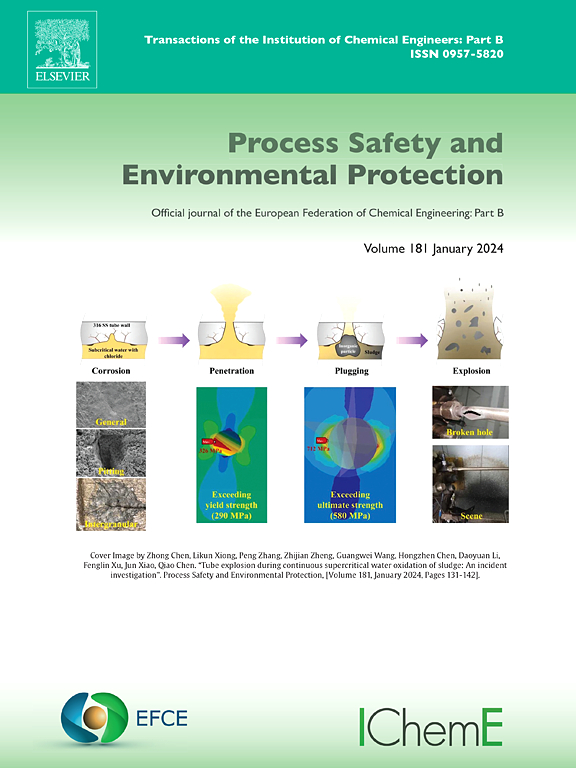On thermal safety characteristics of rechargeable alkaline batteries based on zinc and manganese dioxide
IF 6.9
2区 环境科学与生态学
Q1 ENGINEERING, CHEMICAL
引用次数: 0
Abstract
As lithium-ion technology's exhibits inherent issues with safety due to thermal runaway, a sustainable and cheaper alternative has been proposed in this work: the rechargeable alkaline battery chemistry. However, so far, the postulated safety of the new battery chemistry has not been demonstrated adequately. Therefore, a safety study is being carried out for rechargeable alkaline battery cells. This Short Communication paper is the first report on the thermal safety of Zn-MnO₂ CR2032 rechargeable alkaline battery coin cells. 100 % charged coin cells were tested under thermal abuse conditions in a gravity-convection furnace to quantify the temperature at which the cell would go into thermal runaway. Morphological characterisation of pristine and tested cells was performed via laboratory-based X-ray computed microtomography. The onset temperature to thermal runaway for the rechargeable alkaline battery cells was found to be in the range of 290–380 °C, much higher than that reported in the literature for lithium-ion cells (150–200 °C) of similar capacity and geometry. These results emphasise that rechargeable alkaline battery technology has improved thermal stability compared to lithium-ion technology. Lastly, morphological analyses highlighted the variations of cell geometry brought about by thermal testing.
二氧化锌锰可充电碱性电池热安全特性研究
由于锂离子技术由于热失控而表现出固有的安全问题,因此在这项工作中提出了一种可持续且更便宜的替代方案:可充电碱性化学电池。然而,到目前为止,新电池化学物质的安全性还没有得到充分的证明。因此,人们正在对可充电碱性电池进行安全性研究。这篇简短的通讯论文是关于zn - mno2 CR2032可充电碱性硬币电池热安全性的第一篇报道。在重力对流炉中,在热滥用条件下测试了100% 带电硬币电池,以量化电池进入热失控的温度。形态学特征的原始和测试细胞是通过实验室为基础的x射线计算机微断层扫描。研究发现,可充电碱性电池的热失控起始温度在290 ~ 380℃,远高于同等容量和几何形状的锂离子电池(150 ~ 200℃)。这些结果强调,与锂离子电池技术相比,可充电碱性电池技术具有更好的热稳定性。最后,形态学分析强调了热测试带来的细胞几何变化。
本文章由计算机程序翻译,如有差异,请以英文原文为准。
求助全文
约1分钟内获得全文
求助全文
来源期刊

Process Safety and Environmental Protection
环境科学-工程:化工
CiteScore
11.40
自引率
15.40%
发文量
929
审稿时长
8.0 months
期刊介绍:
The Process Safety and Environmental Protection (PSEP) journal is a leading international publication that focuses on the publication of high-quality, original research papers in the field of engineering, specifically those related to the safety of industrial processes and environmental protection. The journal encourages submissions that present new developments in safety and environmental aspects, particularly those that show how research findings can be applied in process engineering design and practice.
PSEP is particularly interested in research that brings fresh perspectives to established engineering principles, identifies unsolved problems, or suggests directions for future research. The journal also values contributions that push the boundaries of traditional engineering and welcomes multidisciplinary papers.
PSEP's articles are abstracted and indexed by a range of databases and services, which helps to ensure that the journal's research is accessible and recognized in the academic and professional communities. These databases include ANTE, Chemical Abstracts, Chemical Hazards in Industry, Current Contents, Elsevier Engineering Information database, Pascal Francis, Web of Science, Scopus, Engineering Information Database EnCompass LIT (Elsevier), and INSPEC. This wide coverage facilitates the dissemination of the journal's content to a global audience interested in process safety and environmental engineering.
 求助内容:
求助内容: 应助结果提醒方式:
应助结果提醒方式:


